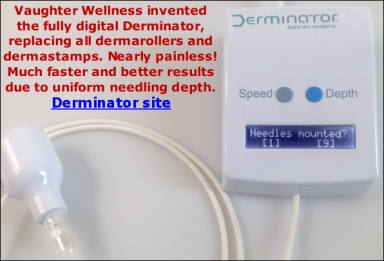The needle length depends on how deep in the skin the problem resides. Whether the problem is in the epidermis or in the dermis and how deeply in the dermis.
I will paste here what I wrote in another thread:
The skin consists of the epidermis and the dermis. The epidermis is very thin comparing to the dermis.
Total skin thickness varies depending where on the body it is (the thinnest skin is on the eyelids, approx. 0.5 mm, the thickest is on the foot soles, approx. 4 mm) and it also varies individually but it is on average between 1 - 2 mm thick in total.
The thickness of the epidermis also depends on where on the body it is. The epidermis on the eyelids is about 0.05 mm thick. The epidermis on the foot soles is about 1.5 mm thick. The face has on average about a 0.1 to 0.3 mm thick epidermis.
Thus a 0.25 mm dermaroller will affect and improve the tone, texture and thickness of the epidermis.
A 0.5 mm roller will even reach the top layer of the dermis. When the skin gets red, it means the desired processes in the skin were trigged:
https://http://owndoc.com/dermarolling/how-dermarolling-works/...but it does not necessarily mean you have gone deep enough because the skin gets red even from rolling with a 0.2 mm dermaroller. It only means the needles did penetrate the skin and the rolling was dense enough.
However, any size that reaches the dermis will address the problems in the dermis.
Most scars are usually deep (except for shallow acne scars etc.) and you should stamp them with a 1.5 mm dermastamp. A dermastamp penetrates deeper than a dermarolloller of the same needle length (unless you push the roller into the skin with very much force). A 1.5 mm dermastamp normally penetrates about as deep as a 2 mm dermaroller.
Pigmentation problems and overall skin texture are often improved by frequent rolls with a 0.5 mm dermaroller.
Under the skin there is mainly fat but also larger blood vessels, nerves, connective tissue, lymphatic vessels, sweat glands, hair follicles etc.
We do not sell needles longer than 2 mm.





